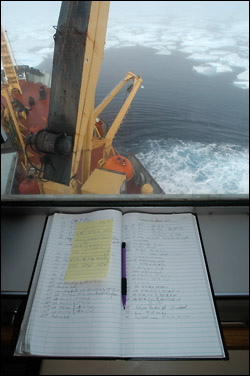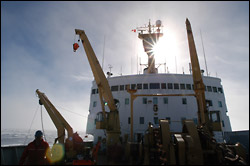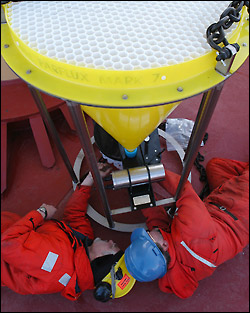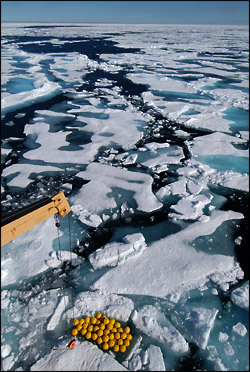Please note: You are viewing
the unstyled version of this website. Either your browser does not support CSS
(cascading style sheets) or it has been disabled. Skip
navigation.
Chris LinderAugust 9, 2005
It was no accident that the buoy came up so perfectly, though. John and Kris spent the entire morning surveying the mooring to make sure they knew exactly--and by exactly I mean within a few feet--where that buoy was going to pop up. Then the Captain spent a few hours softening up the ice by driving the Louis in circles, pounding the solid floes into rubble. The worst thing that can happen during a recovery is to have the mooring trapped underneath a solid floe, and all of that preparation paid off today. After the big orange top sphere bobbed to the surface, John and Kris and the deck crew wasted no time. They quickly attached a line to the float and hauled it aboard. Then they proceeded to reel in over two miles of cable, detaching instruments from the wire as they came up. There were a few more terrifying moments to come, as big floes snagged the mooring line. Here again deft maneuvering from the bridge and judicious use of the compressed air bubbler system kept the cable--and a year's worth of data--safe. As the afternoon wore on, the morning fog burned off to reveal the bluest sky I have ever seen. The reappearance of the sun after so many days of thick fog had a rejuvenating effect on everyone. Smiles and jokes broke out as warmth and light flooded the deck. By dinnertime all of the instruments were retrieved and a hungry crowd invaded the galley. This mooring is one of four that will be deployed as part of WHOI principal investigator Andrey Proshutinsky's Beaufort Gyre Observing System. The moorings are critical to our understanding of one of the least explored bodies of water on the planet. Since we deployed them last year, the autonomous moored instruments have been dutifully collecting a variety of oceanographic data, including pressure, temperature, salinity, currents, ice thickness, and sediment flux, beneath the ice pack. Over the course of this five year project we will be able to tell how climate change is affecting the Beaufort Gyre, and how in turn this may impact climate around the world. Last updated: October 7, 2019 | ||||||||||||||||||||||
Copyright ©2007 Woods Hole Oceanographic Institution, All Rights Reserved, Privacy Policy. | ||||||||||||||||||||||






